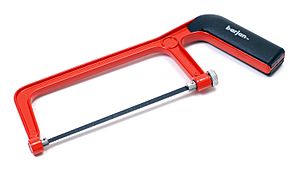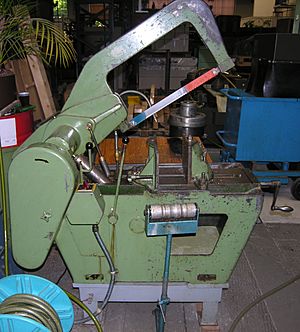Hacksaw facts for kids
A hacksaw is a special kind of saw with very fine teeth. It was first made to cut metal, but it can also cut other things like plastic. If you need to cut wood, you would usually use a bow saw instead.
Most hacksaws are hand saws. They have a C-shaped frame that holds a thin blade very tightly. This frame usually has a handle, often shaped like a pistol grip. The blade is disposable and can be easily attached using pins. Some frames can even be adjusted to fit different blade sizes. A screw or other part helps to pull the thin blade very tight, which is important for cutting well.
When you use a hacksaw, you can set the blade's teeth to face either towards or away from the handle. This means the saw can cut when you push it or when you pull it. For most common uses, like cutting downwards with something held in a vise, the teeth are set to face forward.
Contents
How Hacksaws Are Made
The Story of Hacksaws
People have used saws to cut metal for many years. But in the 1880s, a man named Max Flower-Nash made some big improvements. Another important person was Clemson, who started a company called Clemson Bros., Inc in Middletown, New York.
Clemson did many tests. He changed the size of the blades, the shape of the teeth, and how the blades were heated. He found ways to make blades that cut much better and lasted longer. His company became very successful, selling hacksaw blades called "Star Hack Saw." In 1898, Clemson even got a special paper called a patent for his new hacksaw ideas.
Hacksaw Blades
Standard hacksaw blades are usually about 10 to 12 in (250 to 300 mm) long. Some smaller blades can be as short as 6 in (150 mm). Bigger hacksaws, which are powered by a motor, might use much larger blades.
The number of teeth on a blade is called its "pitch." Hand hacksaw blades can have from 14 to 32 teeth per inch (TPI). Large power hacksaws might have as few as 3 teeth per inch. You choose the blade based on how thick the material you are cutting is. You should always have at least three teeth touching the material at once.
Hacksaw teeth are very small. They are set in a special "wave" pattern. This means the teeth bend slightly from side to side in a smooth curve. This bend creates a wider path, called a wikt:kerf, which stops the blade from getting stuck while you saw.
Hacksaw blades are usually quite easy to break if you're not careful. Older blades were made of carbon steel. These were softer and bent more, so they didn't break easily. But they also wore out quickly. Today, these "low alloy" blades are mostly used for smaller saws, like the Junior hacksaw.
For many years now, hacksaw blades have used a material called high speed steel for their teeth. This makes them cut much better and last a lot longer. At first, these blades were very hard and could break easily. They were best for cutting things held tightly in a vise. Softer high-speed steel blades were also made. They lasted well and didn't break as easily, but they weren't as good for very precise cuts.
Since the 1980s, most hacksaw blades are "bi-metal." These blades combine the best parts of both types. They have a strip of strong high-speed steel teeth welded to a softer, more flexible back. This makes them strong and less likely to break. Because they are now quite affordable, bi-metal blades are used almost everywhere.
The most common blade size is 12 inches or 300 millimeters long. Hacksaw blades have two holes near their ends to attach them to the saw frame. The 12-inch or 300-millimeter measurement is the distance between the centers of these two holes.
The cut (kerf) made by the blade is a bit wider than the blade itself. This is because of the way the teeth are set. It's usually between 0.030 and 0.063 inches (0.75 and 1.6 millimeters) wide. This depends on how many teeth there are and how they are set.
What Hacksaws Are Used For
Hacksaws were first made to cut metal, and that's still their main job. But they can also cut many other things. For example, plumbers and electricians often use hacksaws to cut plastic pipes and plastic tubing.
Different Kinds of Hacksaws
A panel hacksaw has a special frame. This frame is deep and thin, and it sits right behind the blade's cut. This design lets the saw cut deep into flat pieces of sheet metal without the frame getting in the way. The frame simply follows the blade into the metal sheet.
Junior hacksaws are smaller versions of the regular hacksaw. They use a blade that is half the size. Like coping saws, their blades have small pins that fit into notches on the frame. Junior hacksaws can be handy for small jobs or in tight spaces. However, the blades for Junior hacksaws are not as strong as those for bigger saws. They are only made from the older, simpler steel, which limits what they can cut well.
A power hacksaw (or electric hacksaw) is a type of hacksaw that runs on its own electric motor. Most power hacksaws are large machines that stay in one place. But there are also some smaller, portable ones. These portable saws have been partly replaced by tools like reciprocating saws, which can also use hacksaw blades.
Stationary power hacksaws often have a part that lifts the blade up on the way back. This stops the blade from dragging and wearing out. Some even have a pump that sprays coolant to keep the blade from getting too hot.
Power hacksaws are not used as much in metalworking today as they used to be. Other tools like Bandsaws and cold saws have mostly taken their place. Even though they are less common, new power hacksaws are still made. Very old power hacksaws, which were powered by large engines and long spinning rods (called line shafts), are now very rare. You might only see them in museums or with people who collect old tools.
Images for kids
See also
 In Spanish: Sierra para metales para niños
In Spanish: Sierra para metales para niños






